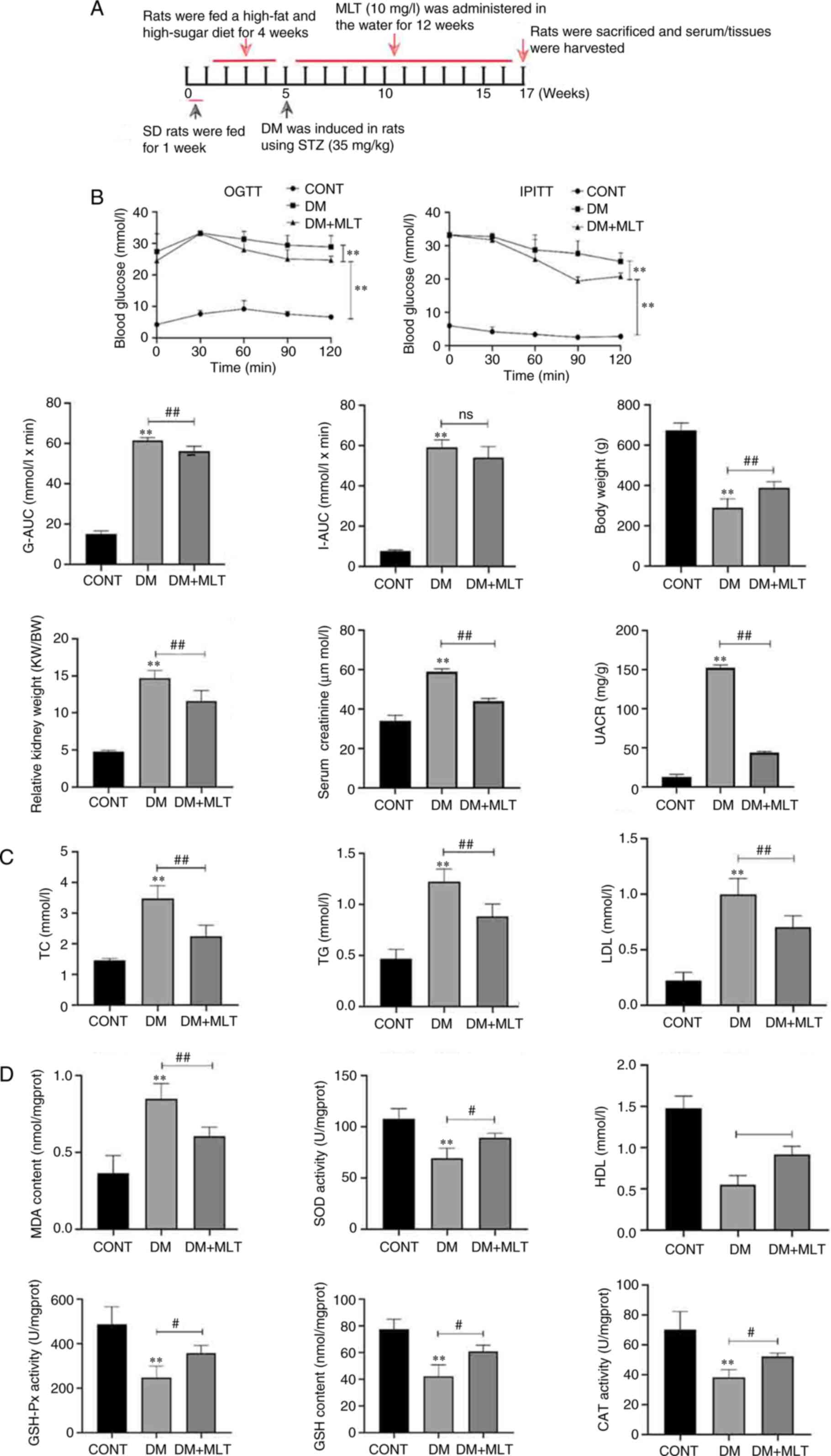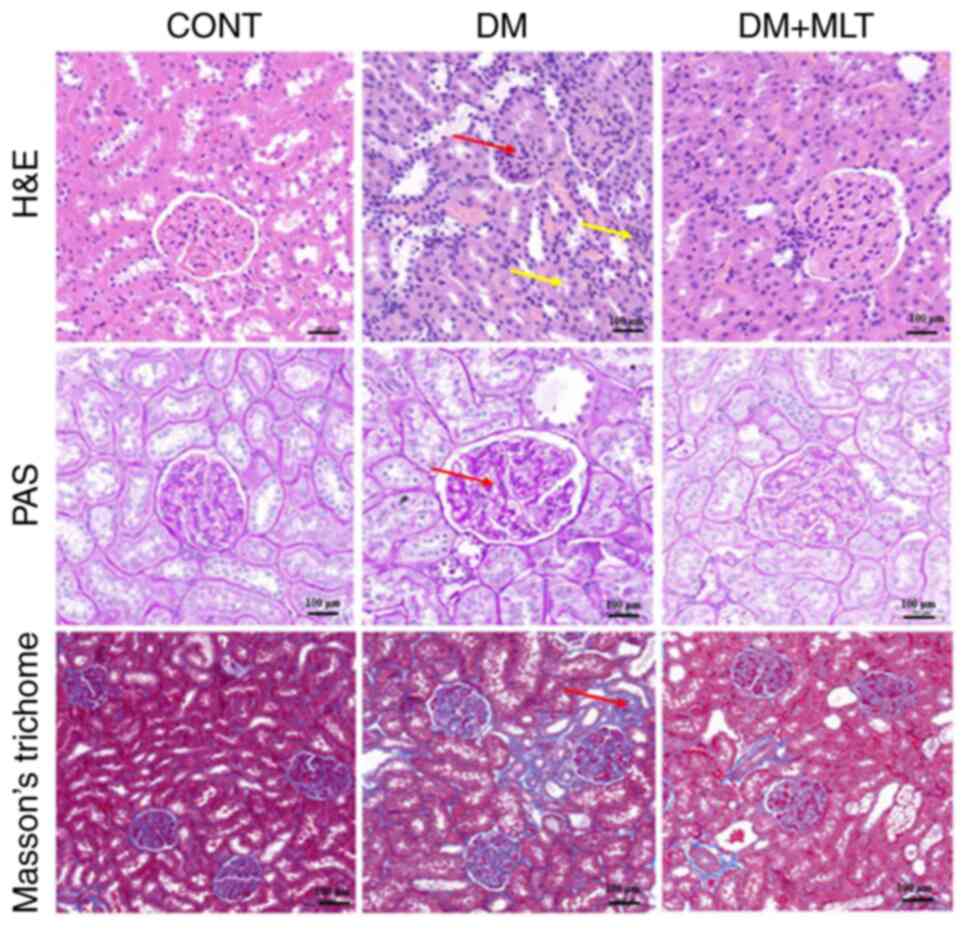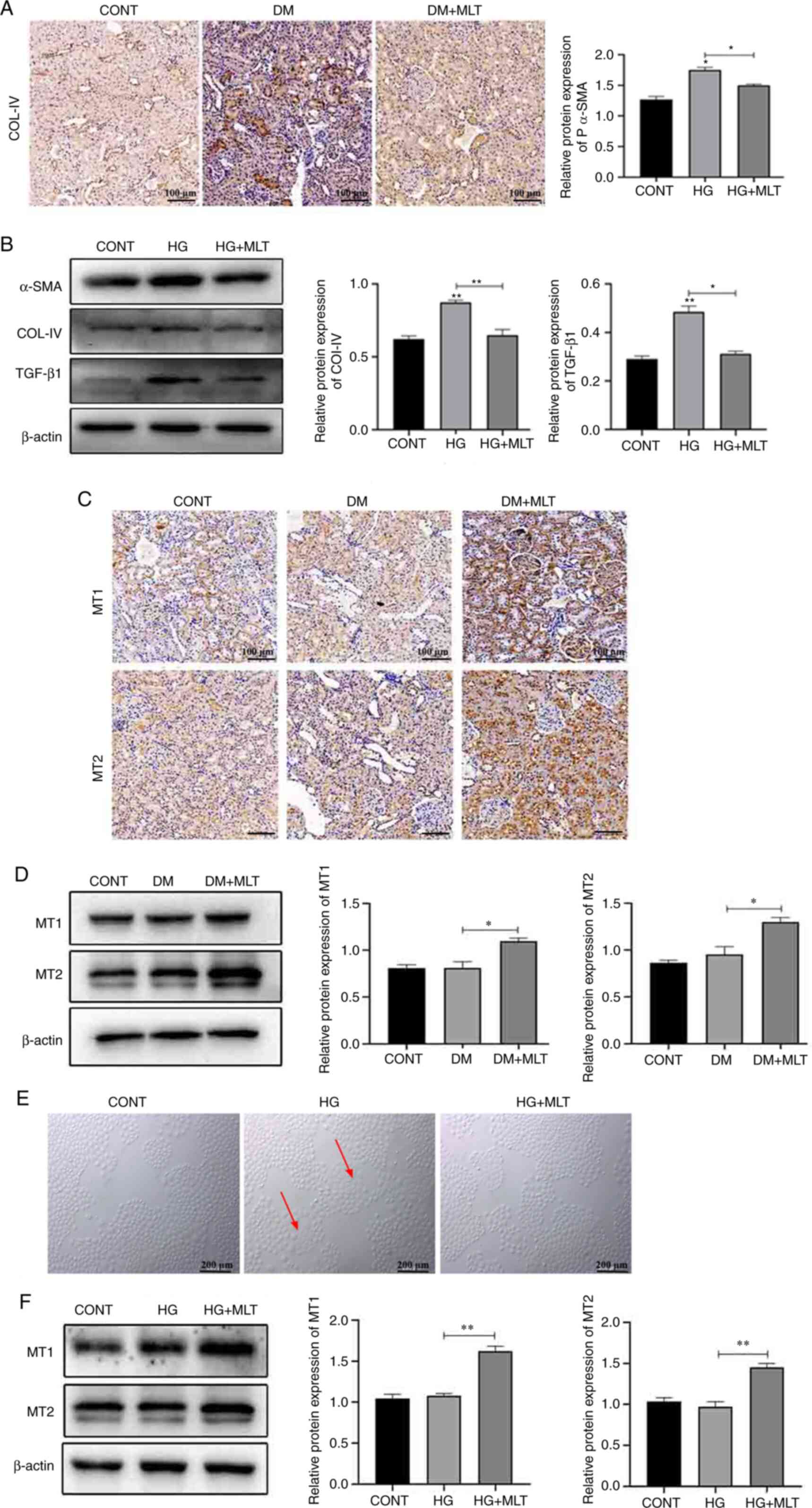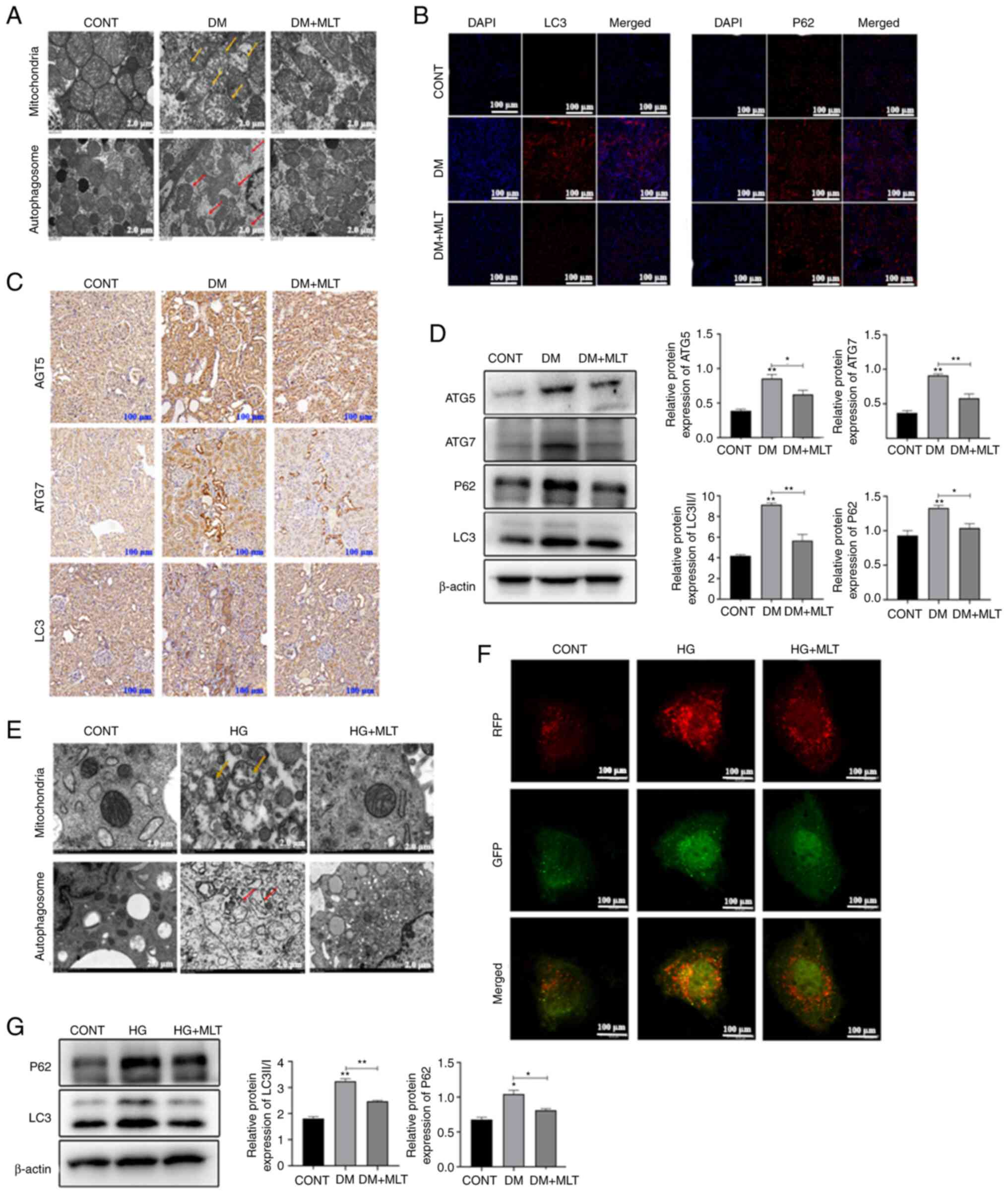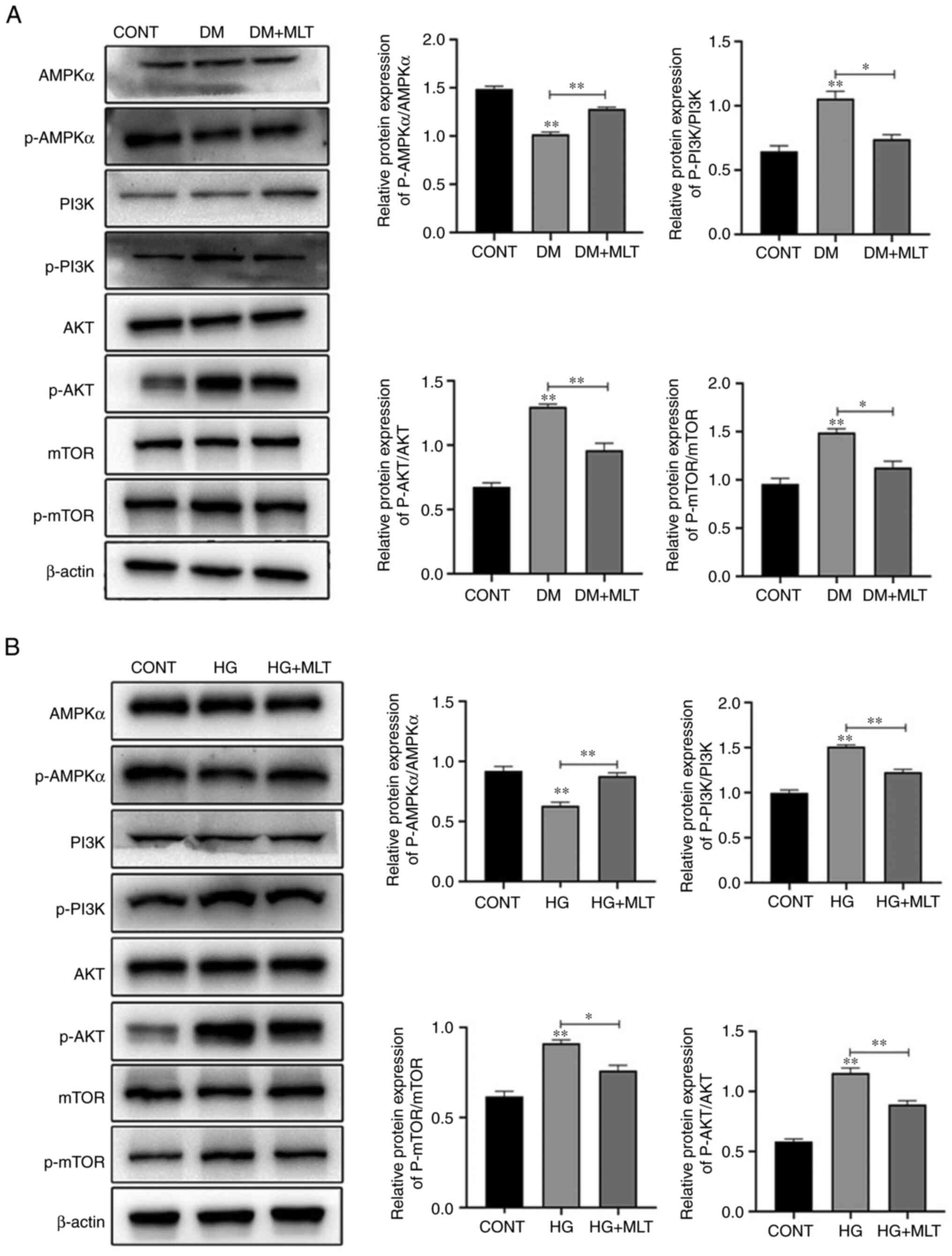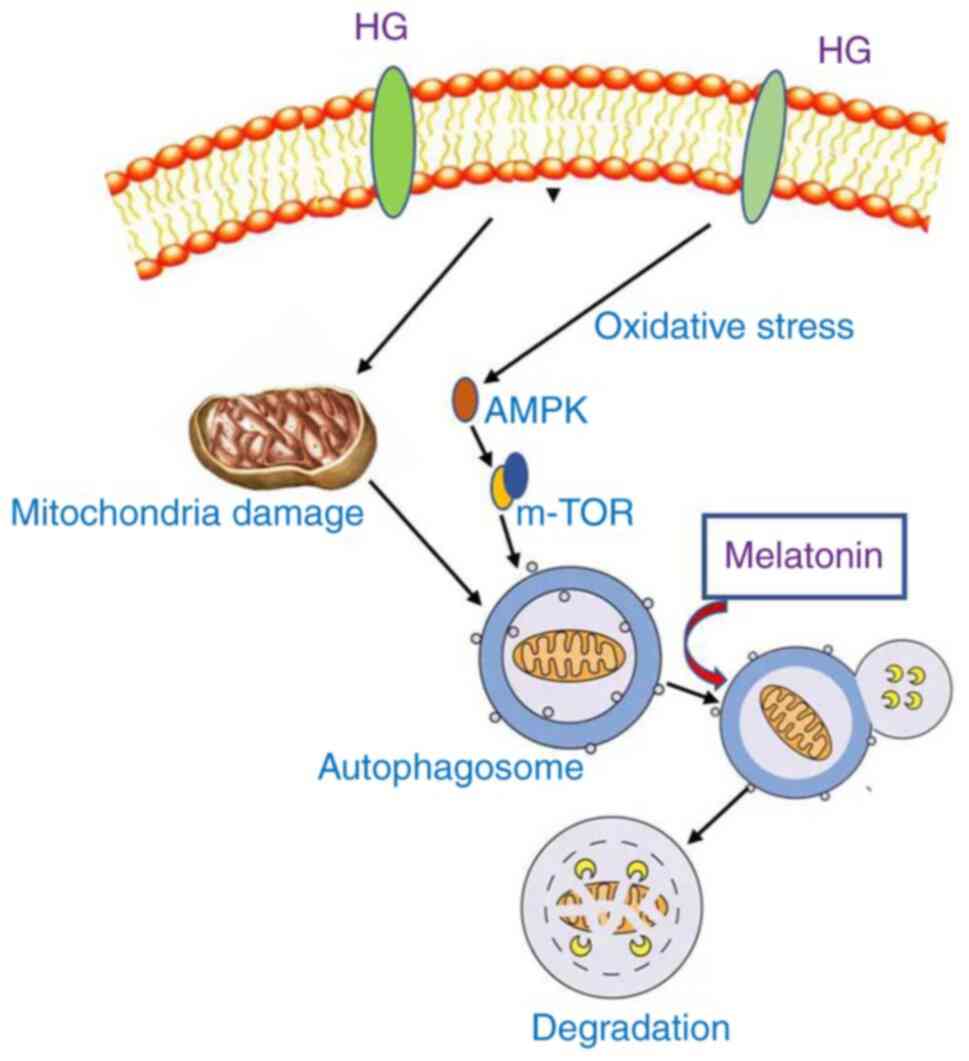|
1
|
Sha J, Sui B, Su X, Meng Q and Zhang C:
Alteration of oxidative stress and inflammatory cytokines induces
apoptosis in diabetic nephropathy. Mol Med Rep. 16:7715–7723. 2017.
View Article : Google Scholar : PubMed/NCBI
|
|
2
|
Thibodeau JF, Holterman CE, Burger D, Read
NC, Reudelhuber TL and Kennedy CR: A novel mouse model of advanced
diabetic kidney disease. PLoS One. 9:e1134592014. View Article : Google Scholar : PubMed/NCBI
|
|
3
|
Gao Y, Ma Y, Xie D and Jiang H: ManNAc
protects against podocyte pyroptosis via inhibiting mitochondrial
damage and ROS/NLRP3 signaling pathway in diabetic kidney injury
model. Int Immunopharmacol. 107:1087112022. View Article : Google Scholar : PubMed/NCBI
|
|
4
|
Zhong Y, Liu J, Sun D, Guo T, Yao Y, Xia
X, Shi C and Peng X: Dioscin relieves diabetic nephropathy via
suppressing oxidative stress and apoptosis, and improving
mitochondrial quality and quantity control. Food Funct.
13:3660–3673. 2022. View Article : Google Scholar : PubMed/NCBI
|
|
5
|
Teh YM, Mualif SA and Lim SK: A
comprehensive insight into autophagy and its potential signaling
pathways as a therapeutic target in podocyte injury. Int J Biochem
Cell Biol. 143:1061532022. View Article : Google Scholar : PubMed/NCBI
|
|
6
|
Medras ZJH, Mostafa YM, Ahmed AAM and
EI-Sayed NM: Arctigenin improves neuropathy via ameliorating
apoptosis and modulating autophagy in streptozotocin-induced
diabetic mice. CNS Neurosci Ther. May 11–2023.(Epub ahead of
print). View Article : Google Scholar : PubMed/NCBI
|
|
7
|
Wang LH, Wang YY, Liu L and Gong Q: From
diabetes to diabetic complications: Role of autophagy. Curr Med
Sci. 43:434–444. 2023. View Article : Google Scholar : PubMed/NCBI
|
|
8
|
Liu L, Dai WZ, Zhu XC and Ma T: A review
of autophagy mechanism of statins in the potential therapy of
Alzheimer's disease. J Integr Neurosci. 21:462022. View Article : Google Scholar : PubMed/NCBI
|
|
9
|
Feng H, Wang N, Zhang N and Liao HH:
Alternative autophagy: Mechanisms and roles in different diseases.
Cell Commun Signal. 20:432022. View Article : Google Scholar : PubMed/NCBI
|
|
10
|
Lim JH, Kim HW, Kim MY, Kim TW, Kim EN,
Kim Y, Chung S, Kim YS, Choi BS, Kim YS, et al: Cinacalcet-mediated
activation of the CaMKKβ-LKB1-AMPK pathway attenuates diabetic
nephropathy in db/db mice by modulation of apoptosis and autophagy.
Cell Death Dis. 9:2702018. View Article : Google Scholar : PubMed/NCBI
|
|
11
|
Song FQ, Song M, Ma WX, Gao Z, Ti Y, Zhang
X, Hu BA, Zhong M, Zhang W and Yu Y: Overexpressing STAMP2
attenuates diabetic renal injuries via upregulating autophagy in
diabetic rats. Biochem Biophys Res Commun. 579:47–53. 2021.
View Article : Google Scholar : PubMed/NCBI
|
|
12
|
Lian CY, Chu BI, Xia WH, Wang ZY, Fan RF
and Wang L: Persistent activation of Nrf2 in a p62-dependent
non-canonical manner aggravates lead-induced kidney injury by
promoting apoptosis and inhibiting autophagy. J Adv Res. 46:87–100.
2023. View Article : Google Scholar : PubMed/NCBI
|
|
13
|
Hsiao CC, Lin CC, Hou YS, Ko JY and Wang
CJ: Low-energy extracorporeal shock wave ameliorates streptozotocin
induced diabetes and promotes pancreatic beta cells regeneration in
a rat model. Int J Mol Sci. 20:49342019. View Article : Google Scholar : PubMed/NCBI
|
|
14
|
Owino S, Contreras-Alcantara S, Baba K and
Tosini G: Melatonin signaling controls the daily rhythm in blood
glucose levels independent of peripheral clocks. PLoS One.
11:e01482142016. View Article : Google Scholar : PubMed/NCBI
|
|
15
|
Agil A, Chayah M, Visiedo L,
Navarro-Alarcon M, Rodríguez Ferrer JM, Tassi M, Reiter RJ and
Fernández-Vázquez G: Melatonin improves mitochondrial dynamics and
function in the kidney of Zücker diabetic fatty rats. J Clin Med.
9:29162020. View Article : Google Scholar : PubMed/NCBI
|
|
16
|
Yapislar H, Haciosmanoglu E, Sarioglu T
and Ekmekcioglu C: The melatonin MT2 receptor is
involved in the anti-apoptotic effects of melatonin in rats with
type 2 diabetes mellitus. Tissue Cell. 76:1017632022. View Article : Google Scholar : PubMed/NCBI
|
|
17
|
Wang W, Zhang J, Wang X, Wang H, Ren Q and
Li Y: Effects of melatonin on diabetic nephropathy rats via
Wnt/β-catenin signaling pathway and TGF-β-Smad signaling pathway.
Int J Clin Exp Pathol. 11:2488–2496. 2018.PubMed/NCBI
|
|
18
|
Fan Z, Qi X, Yang W and Wu Y: Melatonin
ameliorates renal fibrosis through the inhibition of NF-κB and
TGF-β1/Smad3 pathways in db/db diabetic mice. Arch Med Res.
51:524–534. 2020. View Article : Google Scholar : PubMed/NCBI
|
|
19
|
Wei J, Wang Y, Qi X, Fan Z and Wu Y:
Melatonin ameliorates hyperglycaemia-induced renal inflammation by
inhibiting the activation of TLR4 and TGF-β1/Smad3 signalling
pathway. Am J Transl Res. 12:1584–1599. 2020.PubMed/NCBI
|
|
20
|
Chen YT, Yang CC, Sun CK, Chiang HJ, Chen
YL, Sung PH, Zhen YY, Huang TH, Chang CL, Chen HH, et al:
Extracorporeal shock wave therapy ameliorates
cyclophosphamide-induced rat acute interstitial cystitis though
inhibiting inflammation and oxidative stress-in vitro and in vivo
experiment studies. Am J Transl Res. 6:631–648. 2014.PubMed/NCBI
|
|
21
|
Xu Q and Cheung RTF: Melatonin mitigates
type 1 diabetes-aggravated cerebral ischemia-reperfusion injury
through anti-inflammatory and anti-apoptotic effects. Brain Behav.
e31182023.(Epub ahead of print). View Article : Google Scholar : PubMed/NCBI
|
|
22
|
Yu L, Gong B, Duan W, Fan C, Zhang J, Li
Z, Xue X, Xu Y, Meng D, Li B, et al: Melatonin ameliorates
myocardial ischemia/reperfusion injury in type 1 diabetic rats by
preserving mitochondrial function: Role of AMPK-PGC-1α-SIRT3
signaling. Sci Rep. 7:413372017. View Article : Google Scholar : PubMed/NCBI
|
|
23
|
Zhang Y, Wang Y, Xu J, Tian F, Hu S, Chen
Y and Fu Z: Melatonin attenuates myocardial ischemia-reperfusion
injury via improving mitochondrial fusion/mitophagy and activating
the AMPK-OPA1 signaling pathways. J Pineal Res. 66:e125422019.
View Article : Google Scholar : PubMed/NCBI
|
|
24
|
Siddhi J, Sherkhane B, Kalavala AK, Arruri
V, Velayutham R and Kumar A: Melatonin prevents diabetes-induced
nephropathy by modulating the AMPK/SIRT1 axis: Focus on autophagy
and mitochondrial dysfunction. Cell Biol Int. 46:2142–2157. 2022.
View Article : Google Scholar : PubMed/NCBI
|
|
25
|
Qiu WH, An S, Wang T, Li J, Yu B, Zeng Z,
Chen Z, Lin B, Lin X and Gao YG: Melatonin suppresses ferroptosis
via activation of the Nrf2/HO-1 signaling pathway in the mouse
model of sepsis-induced acute kidney injury. Int Immunopharmacol.
112:1091622022. View Article : Google Scholar : PubMed/NCBI
|
|
26
|
Morya AK, Ramesh PV, Kaur K, Gurnani B,
Heda A, Bhatia K and Sinha A: Diabetes more than retinopathy, it's
effect on the anterior segment of eye. World J Clin Cases.
11:3736–3749. 2023. View Article : Google Scholar : PubMed/NCBI
|
|
27
|
Cooper ME: Pathogenesis, prevention, and
treatment of diabetic nephropathy. Lancet. 352:213–219. 1998.
View Article : Google Scholar : PubMed/NCBI
|
|
28
|
Lu Q, Ji XJ, Zhou YX, Yao XQ, Liu YQ and
Yin XX: Quercetin inhibits the mTORC1/p70S6K signaling-mediated
renal tubular epithelial-mesenchymal transition and renal fibrosis
in diabetic nephropathy. Pharmacol Res. 99:237–247. 2015.
View Article : Google Scholar : PubMed/NCBI
|
|
29
|
Kashihara N, Haruna Y, Kondeti VK and
Kanwar YS: Oxidative stress in diabetic nephropathy. Curr Med Chem.
17:4256–4269. 2010. View Article : Google Scholar : PubMed/NCBI
|
|
30
|
Ichimiya T, Yamakawa T, Hirano T, Yokoyama
Y, Hayashi Y, Hirayama D, Wagatsuma K, Itoi T and Nakase H:
Autophagy and autophagy-related diseases: A review. Int J Mol Sci.
21:89742020. View Article : Google Scholar : PubMed/NCBI
|
|
31
|
Gonzalez CD, Lee MS, Marchetti P,
Pietropaolo M, Towns R, Vaccaro MI, Watada H and Wiley JW: The
emerging role of autophagy in the pathophysiology of diabetes
mellitus. Autophagy. 7:2–11. 2011. View Article : Google Scholar : PubMed/NCBI
|
|
32
|
Rubinsztein DC, Mariño G and Kroemer G:
Autophagy and aging. Cell. 146:682–695. 2011. View Article : Google Scholar : PubMed/NCBI
|
|
33
|
Ding DF, You N, Wu XM, Xu JR, Hu AP, Ye
XL, Zhu Q, Jiang XQ, Miao H, Liu C and Lu YB: Resveratrol
attenuates renal hypertrophy in early-stage diabetes by activating
AMPK. Am J Nephrol. 31:363–374. 2010. View Article : Google Scholar : PubMed/NCBI
|
|
34
|
Xu XH, Ding DF, Yong HJ, Dong CL, You N,
Ye XL, Pan ML, Ma JH, You Q and Lu YB: Resveratrol
transcriptionally regulates miRNA-18a-5p expression ameliorating
diabetic nephropathy via increasing autophagy. Eur Rev Med
Pharmacol Sci. 21:4952–4965. 2017.PubMed/NCBI
|
|
35
|
Li C and Siragy HM: (Pro)renin receptor
regulates autophagy and apoptosis in podocytes exposed to high
glucose. Am J Physiol Endocrinol Metab. 309:E302–E310. 2015.
View Article : Google Scholar : PubMed/NCBI
|
|
36
|
Ma T, Zhu J, Chen X, Zha D, Singhal PC and
Ding G: High glucose induces autophagy in podocytes. Exp Cell Res.
319:779–789. 2013. View Article : Google Scholar : PubMed/NCBI
|
|
37
|
Wei M, Li Z and Yang Z: Crosstalk between
protective autophagy and NF-κB signal in high glucose-induced
podocytes. Mol Cell Biochem. 394:261–273. 2014. View Article : Google Scholar : PubMed/NCBI
|
|
38
|
Lenoir O, Jasiek M, Hénique C, Guyonnet L,
Hartleben B, Bork T, Chipont A, Flosseau K, Bensaada I, Schmitt A,
et al: Endothelial cell and podocyte autophagy synergistically
protect from diabetes-induced glomerulosclerosis. Autophagy.
11:1130–1145. 2015. View Article : Google Scholar : PubMed/NCBI
|
|
39
|
Dong C, Zheng H, Huang S, You N, Xu J, Ye
X, Zhu Q, Feng Y, You Q, Miao H, et al: Heme oxygenase-1 enhances
autophagy in podocytes as a protective mechanism against high
glucose-induced apoptosis. Exp Cell Res. 337:146–159. 2015.
View Article : Google Scholar : PubMed/NCBI
|
|
40
|
Katsuragi Y, Ichimura Y and Komatsu M:
p62/SQSTM1 functions as a signaling hub and an autophagy adaptor.
FEBS J. 282:4672–4678. 2015. View Article : Google Scholar : PubMed/NCBI
|
|
41
|
Han YP, Liu LJ, Yan JL, Chen MY, Meng XF,
Zhou XR and Qian LB: Autophagy and its therapeutic potential in
diabetic nephropathy. Front Endocrinol (Lausanne). 14:11394442023.
View Article : Google Scholar : PubMed/NCBI
|
|
42
|
Komatsu M, Kageyama S and Ichimura Y:
p62/SQSTM1/A170: Physiology and pathology. Pharmacol Res.
66:457–462. 2012. View Article : Google Scholar : PubMed/NCBI
|
|
43
|
Herzig S and Shaw RJ: AMPK: Guardian of
metabolism and mitochondrial homeostasis. Nat Rev Mol Cell Biol.
19:121–135. 2018. View Article : Google Scholar : PubMed/NCBI
|
|
44
|
Kma L and Baruah TJ: The interplay of ROS
and the PI3K/Akt pathway in autophagy regulation. Biotechnol Appl
Biochem. 69:248–264. 2022. View Article : Google Scholar : PubMed/NCBI
|
|
45
|
Gwinn DM, Shackelford DB, Egan DF,
Mihaylova MM, Mery A, Vasquez DS, Turk BE and Shaw RJ: AMPK
phosphorylation of raptor mediates a metabolic checkpoint. Mol
Cell. 30:214–226. 2008. View Article : Google Scholar : PubMed/NCBI
|
|
46
|
Tan DX, Hardeland R, Back K, Manchester
LC, Alatorre-Jimenez MA and Reiter RJ: On the significance of an
alternate pathway of melatonin synthesis via 5-methoxytryptamine:
Comparisons across species. J Pineal Res. 61:27–40. 2016.
View Article : Google Scholar : PubMed/NCBI
|
|
47
|
Linowiecka K, Slominski AT, Reiter RJ,
Böhm M, Steinbrink K, Paus R and Kleszczyński K: Moletanin: A
potential regulator of DNA methylation. Antioxidants (Basel).
12:11552023. View Article : Google Scholar : PubMed/NCBI
|
|
48
|
Shao R, Wang Y, He C and Chen L: Melatonin
and its emerging physiological role in reproduction: A review and
update. Curr Mol Med. Apr 17–2023.(Epub ahead of print). PubMed/NCBI
|
|
49
|
Zhang H, Zhang HM, Wu LP, Tan DX, Kamat A,
Li YQ, Katz MS, Abboud HE, Reiter RJ and Zhang BX: Impaired
mitochondrial complex III and melatonin responsive reactive oxygen
species generation in kidney mitochondria of db/db mice. J Pineal
Res. 51:338–344. 2011. View Article : Google Scholar : PubMed/NCBI
|
|
50
|
Dun RL, Lan TY, Tsai J, Mao JM, Shao YQ,
Hu XH, Zhu WJ, Qi GC and Peng Y: Protective effect of melatonin for
renal ischemia-reperfusion injury: A systematic review and
meta-analysis. Front Physiol. 12:7910362022. View Article : Google Scholar : PubMed/NCBI
|
|
51
|
Song D, Liu Y, Yao Y, Liu F, Tao W, Zhou
X, Li R, Zhang X and Li X: Melatonin improves bisphenol A-induced
cell apoptosis, oxidative stress and autophagy impairment via
inhibition of the p38 MAPK signaling pathway in FLK-BLV cells.
Environ Toxicol. 37:1551–1562. 2022. View Article : Google Scholar : PubMed/NCBI
|
|
52
|
Qiao S, Sun Y, Jiang Y, Chen X, Cai J, Liu
Q and Zhang Z: Melatonin ameliorates nickel induced autophagy in
mouse brain: Diminution of oxidative stress. Toxicology.
473:1532072022. View Article : Google Scholar : PubMed/NCBI
|
|
53
|
Lim HD, Kim YS, Ko SH, Yoon IJ, Cho SG,
Chun YH, Choi BJ and Kim EC: Cytoprotective and anti-inflammatory
effects of melatonin in hydrogen peroxide-stimulated CHON-001 human
chondrocyte cell line and rabbit model of osteoarthritis via the
SIRT1 pathway. J Pineal Res. 53:225–237. 2012. View Article : Google Scholar : PubMed/NCBI
|















